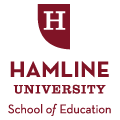Term
Spring 4-18-2016
Capstone
Dissertation
Degree Name
EdD
Primary Advisor/Dissertation Chair
Walter Enloe
Secondary Advisor/Reader One
Charlayne Myers
Peer-Reviewer/Reader Two
Harald K. Faber
Abstract
The purpose of this study was to investigate the ways in which public secondary education has impacted the cultural identities of Native American students who were at one time enrolled therein, or regarding their current perspectives on how the cultural identities of youth within their families currently attending a public secondary school are being impacted. The study began with an autoethnographic submission whereby the researcher’s own experience as both a Native American student and educator was also included as a part of the research. From there, additional data was sought and collected through the use of intensive interviews with subjects chosen from select demographic pools within the Native American community (including both recent graduates and elders). Once completed, the study then analyzed the data to answer the following questions: How do Native American students that have recently graduated from a public secondary school describe their experiences as it relates to the impact it had on their sense of cultural identity? What are the views held by Native American elders regarding high school today in relation to its impact upon Native American student’s cultural identity as they see it - and how do they believe today’s experience compares to their own experience as high school students? Seven participants were involved with the research – three Native American elders over the age of forty-five, three Native American adults under the age of twenty-five, and the researcher himself (a thirty-nine year old male). All of the participants had attended some variation of a public secondary school, and a few of the elders involved also had youth within their families who were currently enrolled. The research process examined the stories related by the participants as to what they or their family members experienced as students within a public secondary school, how it affected their sense of cultural identity, and what they hoped might be changed for future generations to improve the experience of mandatory matriculation. From these stories, and the data that was collected and analyzed through a process of triangulation between the three data sources, and a new theory emerged relating to the impact that public education has had upon the cultural identities of these Native American participants, and what they would like to see happen going forward. Derived from the data, the new theory is as follows:
Owing to systemic failures within the public high school system – not only historical in nature but that which is also ongoing at the present time – members of the Native American community now believe that there is a responsibility incumbent upon the public high school system to actively support and to further Native American student understandings relating to their own cultural identities. This can be accomplished through the incorporation of such practices as indigenous language revitalization, increased course offerings centered upon Native American practices and history, unique classroom designs that include outdoor classes, and the inclusion of more cultural experts within the classroom as a knowledge resource. In so doing, public high schools will at long last join together with current and future Native American students in honoring the sacrifices made by their ancestors, and earn absolution for past transgressions by ensuring the ability of indigenous cultures to survive for future generations.
Research Methodology
Grounded Theory, Autoethnographic
Keywords
Multicultural Education, Social Justice
Recommended Citation
Hobot, Joseph Vincent, "Assessing the Impact of Public Secondary School on the Cultural Identities of Native American Students" (2016). School of Education and Leadership Student Capstone Theses and Dissertations. 4088.
https://digitalcommons.hamline.edu/hse_all/4088

